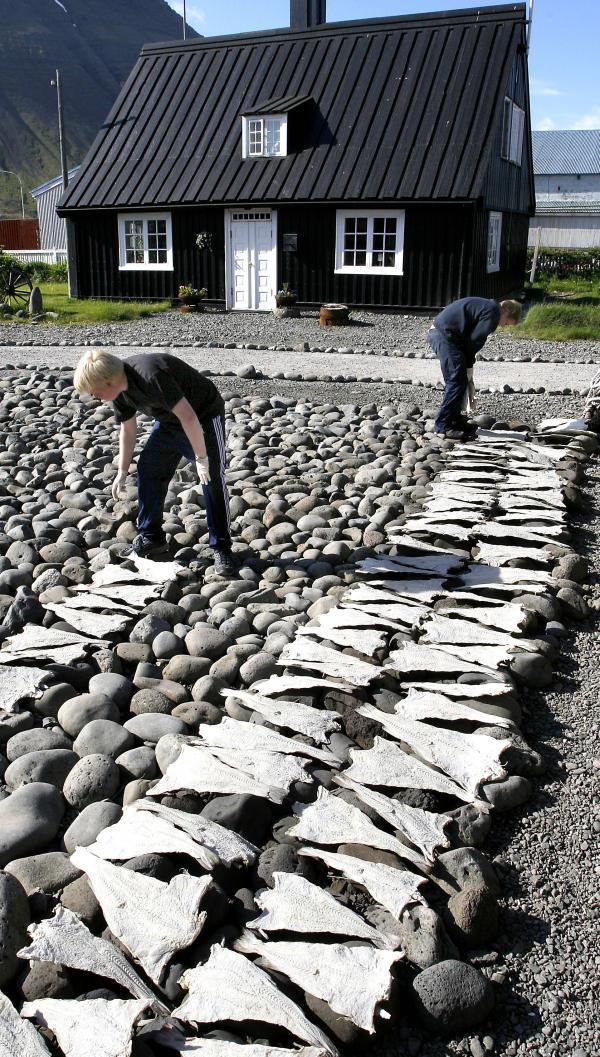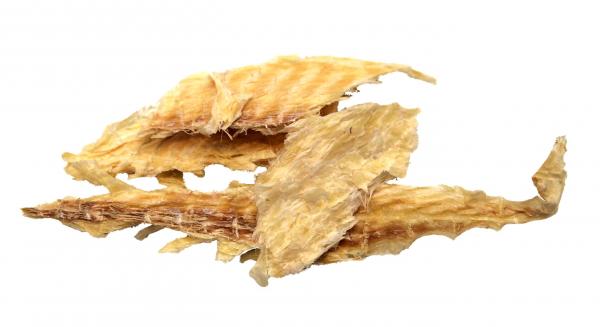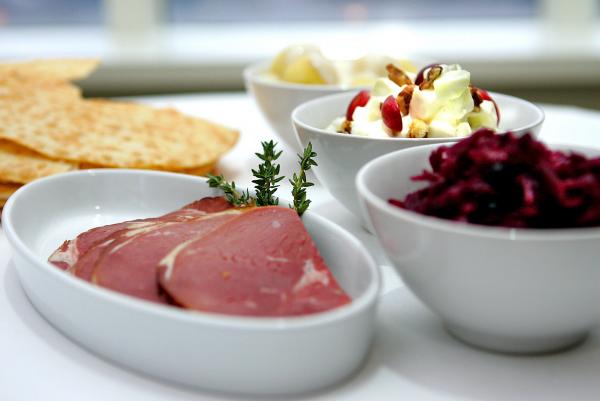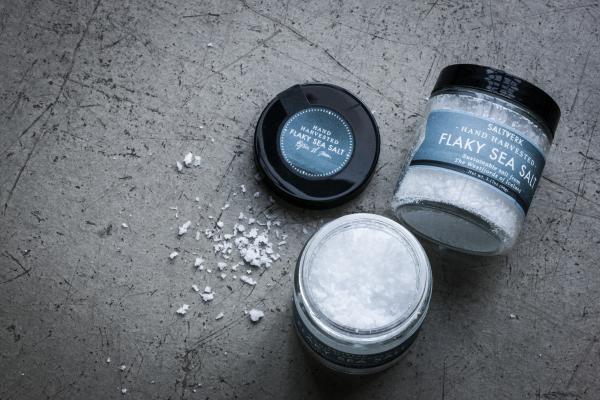The Ark of Taste is an international list of products of endangered heritage foods that is maintained by the global Slow Food movement. It is designed to preserve at-risk foods that are sustainably produced, unique in taste, and part of a distinct ecoregion. The Ark was conceived in Italy in 1996 and has since grown considerably in size.
To be included in the Ark, a food product must fulfil a number of criteria, such as being linked to a specific area or tradition, be produced in limited quantities and be at risk of extinction. Several Icelandic food products meet the criteria and have been included in the Ark of Taste.

Sun-dried salted cod
Dried and salted cod has been produced in Iceland, Norway, Faroe Islands, and Newfoundland for over five hundred years. Traditionally the fish was laid to dry in the sun and wind outdoors.
Where to buy: Fish stores
Fermented shark
Known as kæstur hákarl in Icelandic, fermented shark is traditionally eaten in the old Norse month of Þorri (which begins on a Friday between the 19th and the 25th of January). The meat is cured with a particular fermentation process and hung to dry for four to five months. The curing process removes the ammonia from the flesh and makes it edible.
Where to buy: Most fish stores.
The Icelandic goat
The Icelandic goat, also known as the Settlement goat, is believed to be of Norwegian descent. The breed dates back to the settlement of Iceland in 870 but became close to extinction during the late 19th century.
Around 10 million krónur (64.973 euros / 84.097 US dollars) were raised last autumn through an American internet campaign called “Save the Icelandic Goat from Extinction.” The campaign was launched in a bid to save Iceland’s largest goat farm from being put up for auction.
Where to buy: Goat meat can be bought directly from farmers through the website beintfrabyli.is.

Harðfiskur
Harðfiskur is traditional dried fish (fish jerky), most commonly made from haddock, cod, or wolf fish. For centuries, harðfiskur was one of the staple foods in an Icelander’s diet because of its high protein content and was usually eaten with butter or seaweed. Today, Icelanders produce around 250 tonnes (551,156 pounds) of dried fish annually.
Where to buy: All supermarkets and fish stores.
Traditional skyr
Skyr is a traditional Icelandic dairy product that resembles yogurt, but it is, correctly speaking, a cheese. Skyr-making dates back all the way to the 9th century. The product is made from skim milk, which remains after the cream has been removed. The milk is then warmed, live cultures from previous batches of skyr are added, and after it has thickened, it is strained off from the whey.
Where to buy: Skyr can be bought in all supermarkets.
Read more: Make your own skyr

Smoked lamb
Hangikjöt is a traditional smoked leg of lamb that takes its name from the old tradition of preserving meat by hanging it from the rafters of a smoking shed. The word ‘hangikjöt’ means ‘hung meat.’
Hangikjöt is most commonly eaten as a topping with ‘flatbrauð’ (rye flat-bread) and for Christmas dinner, served with potatoes in béchamel sauce, red cabbage, and green peas.
Where to buy: Hangikjöt can be bought in all supermarkets and directly from farmers.
Flaky sea salt dried with geothermal energy
In Iceland sea salt is dried using energy from hot springs and is called ‘flögusalt þurrkað með jarðvarma’ in Icelandic. Saltverk and Norðursalt are among the companies producing flaky sea salt with geothermal energy. The salt is produced by pumping fresh seawater into evaporation tanks that are heated by natural geothermal water. Geothermal heat is also used to dry the salt.
Where to buy: Most supermarkets.

Read more: Best of Icelandic food & drink: Part One
The Ark of Taste is an international list of products of endangered heritage foods that is maintained by the global Slow Food movement. It is designed to preserve at-risk foods that are sustainably produced, unique in taste, and part of a distinct ecoregion. The Ark was conceived in Italy in 1996 and has since grown considerably in size.
To be included in the Ark, a food product must fulfil a number of criteria, such as being linked to a specific area or tradition, be produced in limited quantities and be at risk of extinction. Several Icelandic food products meet the criteria and have been included in the Ark of Taste.

Sun-dried salted cod
Dried and salted cod has been produced in Iceland, Norway, Faroe Islands, and Newfoundland for over five hundred years. Traditionally the fish was laid to dry in the sun and wind outdoors.
Where to buy: Fish stores
Fermented shark
Known as kæstur hákarl in Icelandic, fermented shark is traditionally eaten in the old Norse month of Þorri (which begins on a Friday between the 19th and the 25th of January). The meat is cured with a particular fermentation process and hung to dry for four to five months. The curing process removes the ammonia from the flesh and makes it edible.
Where to buy: Most fish stores.
The Icelandic goat
The Icelandic goat, also known as the Settlement goat, is believed to be of Norwegian descent. The breed dates back to the settlement of Iceland in 870 but became close to extinction during the late 19th century.
Around 10 million krónur (64.973 euros / 84.097 US dollars) were raised last autumn through an American internet campaign called “Save the Icelandic Goat from Extinction.” The campaign was launched in a bid to save Iceland’s largest goat farm from being put up for auction.
Where to buy: Goat meat can be bought directly from farmers through the website beintfrabyli.is.

Harðfiskur
Harðfiskur is traditional dried fish (fish jerky), most commonly made from haddock, cod, or wolf fish. For centuries, harðfiskur was one of the staple foods in an Icelander’s diet because of its high protein content and was usually eaten with butter or seaweed. Today, Icelanders produce around 250 tonnes (551,156 pounds) of dried fish annually.
Where to buy: All supermarkets and fish stores.
Traditional skyr
Skyr is a traditional Icelandic dairy product that resembles yogurt, but it is, correctly speaking, a cheese. Skyr-making dates back all the way to the 9th century. The product is made from skim milk, which remains after the cream has been removed. The milk is then warmed, live cultures from previous batches of skyr are added, and after it has thickened, it is strained off from the whey.
Where to buy: Skyr can be bought in all supermarkets.
Read more: Make your own skyr

Smoked lamb
Hangikjöt is a traditional smoked leg of lamb that takes its name from the old tradition of preserving meat by hanging it from the rafters of a smoking shed. The word ‘hangikjöt’ means ‘hung meat.’
Hangikjöt is most commonly eaten as a topping with ‘flatbrauð’ (rye flat-bread) and for Christmas dinner, served with potatoes in béchamel sauce, red cabbage, and green peas.
Where to buy: Hangikjöt can be bought in all supermarkets and directly from farmers.
Flaky sea salt dried with geothermal energy
In Iceland sea salt is dried using energy from hot springs and is called ‘flögusalt þurrkað með jarðvarma’ in Icelandic. Saltverk and Norðursalt are among the companies producing flaky sea salt with geothermal energy. The salt is produced by pumping fresh seawater into evaporation tanks that are heated by natural geothermal water. Geothermal heat is also used to dry the salt.
Where to buy: Most supermarkets.

Read more: Best of Icelandic food & drink: Part One







